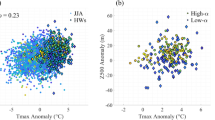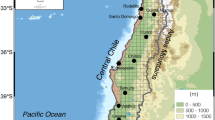Abstract
Over Yangtze River valley (YRV) where heat wave (HW) events most frequently occur in China during 1979–2014, 30 out of 57 HW events (nearly 55%) in July and August is found to be related with the dry phases of atmospheric quasi-biweekly oscillation (QBWO). When a significant low-level anticyclonic anomaly (LAA) associated with QBWO appears over YRV, temperature rises sharply according to the adiabatic heating caused by subsidence and the enhanced downward solar radiation due to decreased clouds. The LAA with subsidence over YRV is primarily generated by quasi-biweekly atmospheric waves, which are classified to three types through case-by-case categorization, named as “mid-latitude wavetrain”, “WNP (western North Pacific) wavetrain” and “double wavetrains”, respectively. The mid-latitude wavetrain QBWO causes the LAA through subsidence induced by upper-level cyclonic vorticity which is associated with an eastward/southeastward migrating wave train from Eastern Europe to WNP in the upper troposphere. The WNP wavetrain QBWO forms LAA through a northwestward migrating lower-tropospheric wave train emanating from tropical WNP to southeastern China. The double wavetrains QBWO triggers LAA through both the low-level shear anticyclonic vorticity provided by a low-level northwestward/westward propagating wave train from tropical WNP to South China Sea and the upper-level positive vorticity associated with an eastward/southeastward migrating wave train from Eastern Europe to southeastern China in the upper troposphere. In all cases, South Asian High extends eastward and WNP subtropical high extends westward during HW events. Tracing these distinct precursory circulation anomalies may facilitate better understanding and short-medium range forecast of HW.













Similar content being viewed by others
References
Anderson GB, Bell ML (2011) Heat waves in the United States: mortality risk during heat waves and effect modification by heat wave characteristics in 43 U.S. Communities. Environ Heal Perspect 119:210–218
Bingham C, Godfrey MD, Tukey JW (1967) Modern techniques of power spectrum estimation. IEEE Trans Audio Electroacous 15 (2):6–66
Bloomfield P (2000) Fourier analysis of time series: an introduction, 2nd edn. Wiley, Hoboken, NJ
Chan JCL, Ai W, Xu J (2002) Mechanisms responsible for the maintenance of the 1998 South China Sea summer monsoon. J Meteorol Soc Jpn 80(5):1103–1113
Chen GH, Sui CH (2010) Characteristics and origin of quasi-biweekly oscillation over the western North Pacific during boreal summer. J Geophys Res Atmos 115 (D14113). doi:10.1029/2009JD013389
Chen JP, Wen ZP, Wu RG, Chen ZS, Zhao P (2015) Influences of northward propagating 25-90-day and quasi-biweekly oscillations on eastern China summer rainfall. Clim Dyn 45:105–124
Dee DP, Uppala SM, Simmons AJ et al (2011) The ERA-Interim reanalysis: configuration and performance of the data assimilation system. Q J Roy MeteorSoc 137(656):553–597
Ding T, Ke ZJ (2015) Characteristics and changes of regional wet and dry heat wave events in China during 1960–2013. Theor Appl Climato 122(3):651–665
Ding T, Qian WH (2011) Geographical patterns and temporal variations of regional dry and wet heatwave events in China during 1960–2008. Adv Atmos Sci 28(2):322–337
Ding T, Qian WH (2012) Statistical characteristics of heat wave precursors in China and model prediction. Chin J Geophys 55 (5):1472–1486 (in Chinese)
Easterling DR, Meehl GA, Parmesan C, Changnon SA, Karl TR, Mearns LO (2000) Climate extremes: observations, modeling, and impacts. Science 289(5487):2068–2074
Enomoto T, Hoskins BJ, Matsuda Y (2003) The formation mechanism of the Bonin high in August. Q J Roy Meteorol Soc 129:157–178
Fujinami H, Yasunari T (2004) Submonthly variability of convection and circulation over and around the Tibetan Plateau during the boreal summer. J Meteorol Soc Jpn 82(6):1545–1564
Gershunov A, Cayan DR, Iacobellis SF (2009) The great 2006 heat wave over California and Nevada: Signal of an Increasing Trend. J Clim 22:6181–6203
Gilbert RO (1987) Statistical methods for environmental pollution monitoring. Wiley, New York, pp 217–219
Gilman DL, Fuglister FJ, Mitchell JM Jr (1963) On the power spectrum of red noise. J Atmos Sci 20(2):182–184
Gong DY, Pan YZ, Wang JA (2004) Changes in extreme daily mean temperatures in summer in eastern China during 1955–2000. Theor Appl Climato 77 (1):25–37
Hartmann DL, Klein Tank AMG, Rusticucci M, Alexander LV, Brönnimann S, Charabi Y, Dentener FJ, Dlugokencky EJ, Easterling DR, Kaplan A, Soden BJ, Thorne PW, Wild M, Zhai PM (2013) Observations: atmosphere and surface. In: Stocker TF, Qin D, Plattner G-K, Tignor M, Allen SK, Boschung J, Nauels A, Xia Y, Bex V, Midgley PM (eds) Climate change 2013: the physical science basis. Contribution of working group I to the fifth assessment report of the intergovernmental panel on climate change. Cambridge University Press, Cambridge and New York, pp 159-254
Hu KM, Huang G, Qu X, Huang RH (2012) The impact of Indian Ocean variability on high temperature extremes across the southern Yangtze River valley in late summer. Adv Atmos Sci 29 (1):91–100
Huang W, Kan HD, Kovats S (2010) The impact of the 2003 heat wave on mortality in Shanghai, China. Sci Total Environ 408(11):2418–2420
Jia XL, Yang S (2013) Impact of the quasi-biweekly oscillation over the western North Pacific on East Asian subtropical monsoon during early summer. J Geophys Res Atmos 118(10):4421–4434
Kendall MG (1975) Rank correlation methods, 4th edn. Charles Griffin, London
Kikuchi K, Wang B (2009) Global perspective of the quasi-biweekly oscillation. J Clim 22(6):1340–1359
Lei YN, Gong DY, Zhang ZY, Guo D, He XZ (2009) Spatial-temporal characteristics of high-temperature events in summer in eastern China and the associated atmospheric circulation. Geogr Res 28(3):653–662 (in Chinese)
Levy R, Hsu C et al (2015) MODIS atmosphere L2 aerosol product. NASA MODIS adaptive processing system, Goddard space flight center. (Terra, USA. 10.5067/MODIS/MYD04_L2.006 (Aqua)
Liu HZ, Zhao SR, Zhao CG, Lu ZS (2006) Weather abnormal and evolutions of western Pacific subtropical high and South Asian High in summer of 2003. Plateau Meteor 25(2):169–178 (in Chinese)
Liu LL, Sun LH, Liao YM, Zhu YF, Zou XK, Wang YM, Yan JH (2008) Development and application of national prediction system for extreme high temperature. Meteorol Mon 34:102–107 (in Chinese)
Liu HB, Yang J, Zhang DL, Wang B (2014) Roles of synoptic to quasi-biweekly disturbances in generating the summer 2003 heavy rainfall in East China. Mon Weather Rev 142(2):886–904
Mao JY, Wu GX (2006) Intraseasonal variations of the Yangtze rainfall and its related atmospheric circulation features during the 1991 summer. Clim Dyn 27 (7):815–830
Meehl GA, Tebaldi C (2004) More intense, more frequent, and longer lasting heat waves in the 21st century. Science 305(5686):994–997
Peng J (2014) An investigation of the formation of the heat wave in southern China in summer 2013 and the relevant abnormal subtropical high activities. Atmos Oceanic Sci Lett 7 (4):286–290
Qian WH, Lin X (2004) Regional trends in recent temperature indices in China. Clim Res 27 (2):119–134
Robinson PJ (2001) On the definition of a heat wave. J Appl Meteor 40(4):762–775
Smith TT, Zaitchik BF, Gohlke JM (2013) Heat waves in the United States: definitions, patterns and trends. Clim chan 118(3):811–825
Steadman RG (1984) A universal scale of apparent temperature. J Clim Appl Meteorol 23:1674–1687
Sun JQ (2012) Possible impact of the summer North Atlantic oscillation on extreme hot events in China. Atmos Oceanic Sci Lett 5(3):231–234
Sun JQ (2014) Record-breaking SST over mid-North Atlantic and extreme high temperature over the Jianghuai-Jiangnan region of China in 2013. Chin Sci Bull 59:3465–3470
Takaya K, Nakamura H (2001) A formulation of a phase-independent wave-activity flux for stationary and migratory quasigeostrophic eddies on a zonally varying basic flow. J Atmos Sci 58:608–627
Teng HY, Branstator G, Wang H, Meehl GA, Washington WM (2013) Probability of US heat waves affected by a subseasonal planetary wave pattern. Nature Geosci 6(12):1056–1061
Wang MR, Duan A (2015) Quasi-biweekly oscillation over the Tibetan plateau and its link with the Asian Summer monsoon. J Clim 28:4921–4940
Wang B, Rui HL (1990) Synoptic climatology of transient tropical intraseasonal convection anomalies. Meteor Atmos Phys 44(1–4):43–61
Wang B, Xu XH (1997) Northern hemisphere summer monsoon singularities and climatological intraseasonal oscillation. J Clim 10(5):1071–1085
Wang B, Liu J, Yang J, Zhou TJ, Wu ZW (2009) Distinct principal modes of early and late summer rainfall anomalies in East Asia. J Clim 22(13):3864–3875
Wu J, Gao XJ (2013) A gridded daily observation dataset over China region and comparison with the other datasets. Chin J Geophys 56(4):1102–1111 (in Chinese)
Wu ZW, Lin H, Li JP, Jiang ZH, Ma TT (2012a) Heat wave frequency variability over North America: two distinct leading modes. J Geophys Res Atmos 117 (D02102). doi:10.1029/2011JD016908
Wu ZW, Jiang ZH, Li JP, Zhong SS, Wang LJ (2012b) Possible association of the western Tibetan Plateau snow cover with the decadal to interdecadal variations of northern China heatwave frequency. Clim Dyn 39 (9):2393–2402
Xu Y, Gao XJ, Shen Y, Xu CH, Shi Y, Giorgi F (2009) A daily temperature dataset over China and its application in validating a RCM simulation. Adv Atmos Sci 26(4):763–772
Yanai M, Esbensen S, Chu JH (1973) Determination of bulk properties of tropical cloud clusters from large-scale heat and moisture budgets. J Atmos Sci 30(4):611–627
Yang SY, Li T (2016) Intraseasonal variability of air temperature over the mid-high latitude Eurasia in boreal winter. Clim Dyn 47:2155–2175
Yang J, Wang B (2008) Anticorrelated intensity change of the quasi-biweekly and 30-50-day oscillations over the South China Sea. Geophys Res Lett 35(L16702). doi:10.1029/2008GL034449
Yang J, Wang B, Bao Q (2010) Biweekly and 21–30 day variabilities of the subtropical East Asian monsoon over the lower reach of Yangtze River Basin. J Clim 23(5):1146–1159
Yang J, Bao Q, Wang B, Gong DY, He HZ, Gao MN (2014) Distinct quasi-biweekly features of the subtropical East Asian monsoon during early and late summers. Clim Dyn 42 (5):1469–1486
Yang J, Bao Q, Wang B, He HZ, Gao MN, Gong DY (2016) Characterizing two types of transient intraseasonal oscillations in the Eastern Tibetan Plateau summer rainfall. Clim Dyn. doi:10.1007/s00382-016-3170-z
Ye DX, Yin JF, Chen ZH, Zheng YF, Wu RJ (2014) Spatial and temporal variations of heat waves in China from 1961 to 2010. Adv Clim Change Res 5 (2):66–73
Zhang RP, Zhou YF, Guo KY (2005) The relation between the persistent high temperature in south of China in the summer of 2003 and the vortex’s position. Sci Meteorol Sin 25(5):528–533 (in Chinese)
Zhao CB, Li T, Zhou TJ (2013) Precursor signals and processes associated with MJO initiation over the tropical Indian Ocean. J Clim 26(1):291–307
Acknowledgements
This study was supported by funds from the National Key Research and Development Program–Global Change and Mitigation Project: Global change risk of population and economic system: mechanism and assessment (Grant No. 2016YFA0602401), the National Natural Science Foundation of China (Grant No. 41375003, Grant No. 41621061 and Grant No. 41420104002) and the project PE16010 of the Korea Polar Research Institute. BW acknowledges the support from Climate Dynamics Program of the National Science Foundation under award No AGS-1540783, NOAA/DYNAMO #NA13OAR4310167 and the National Research Foundation (NRF) of Korea through a Global Research Laboratory (GRL) Grant (MEST, #2011–0021927). This is the ESMC publication number 145.
Author information
Authors and Affiliations
Corresponding author
Rights and permissions
About this article
Cite this article
Gao, M., Yang, J., Wang, B. et al. How are heat waves over Yangtze River valley associated with atmospheric quasi-biweekly oscillation?. Clim Dyn 51, 4421–4437 (2018). https://doi.org/10.1007/s00382-017-3526-z
Received:
Accepted:
Published:
Issue Date:
DOI: https://doi.org/10.1007/s00382-017-3526-z




